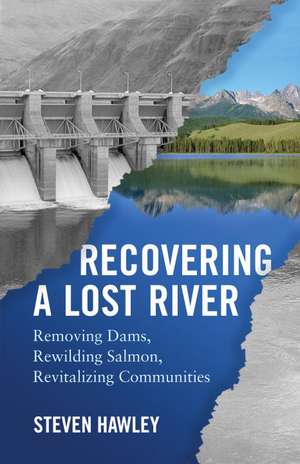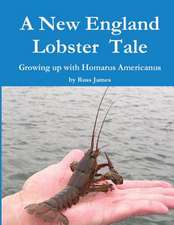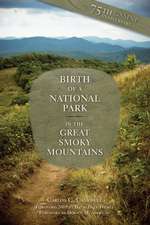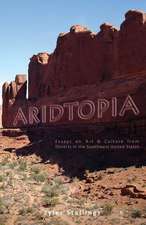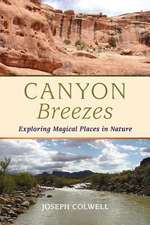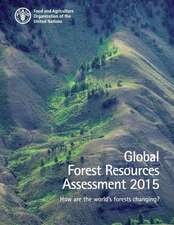Recovering a Lost River: Removing Dams, Rewilding Salmon, Revitalizing Communities
Autor Steven Hawleyen Limba Engleză Paperback – 29 feb 2012
Preț: 162.21 lei
Nou
Puncte Express: 243
Preț estimativ în valută:
31.05€ • 33.74$ • 26.10£
31.05€ • 33.74$ • 26.10£
Carte tipărită la comandă
Livrare economică 21 aprilie-05 mai
Preluare comenzi: 021 569.72.76
Specificații
ISBN-13: 9780807004739
ISBN-10: 0807004731
Pagini: 252
Dimensiuni: 134 x 211 x 19 mm
Greutate: 0.35 kg
Editura: Beacon Press (MA)
ISBN-10: 0807004731
Pagini: 252
Dimensiuni: 134 x 211 x 19 mm
Greutate: 0.35 kg
Editura: Beacon Press (MA)
Recenzii
"[A] hopeful and blistering critique."—Colleen Mondor, Booklist
“An impeccable history of salmon politics beautifully researched and told with humor, despair, and, always, heart and force and clarity. A must-read.”—Rick Bass, author of Winter: Notes from Montana
“After reading Hawley’s very readable Recovering a Lost River, I’m more convinced than ever that U.S. and Canadian government policy toward salmon and steelhead is to extirpate these pesky critters as they are in the way of greedy development, unnecessary dams, illegal profiteering, toxic fish farms, and more useless hatcheries.” —Yvon Chouinard, owner, Patagonia, Inc.
“Hawley writes about the Columbia River Basin from every angle, talking to those whom other writers can’t imagine or muster the courage to address. His style is surprisingly humorous for the subject, thought-provoking, truthful, and unpredictable. He gets it.”—Rebecca A. Miles, executive director, the Nez Perce tribe
“Though there are echoes of some extraordinary authors in Recovering a Lost River—Henry David Thoreau, Aldo Leopold, and Edward Abbey—Steven Hawley writes with his own distinctly twenty-first century voice about the inherent value of wild rivers and the environmental and social degradation caused by dams. Read it and learn—and act.”—Michael Baughman, author of A River Seen Right
“Thanks to Hawley’s meticulous research, we now have a new gold standard for banditry and shameless deception in private industry, state governments, and in the very federal agencies charged with safeguarding the biological integrity of our natural world. God help us.”—Paul VanDevelder, author of Savages and Scoundrels: The Untold Story of America’s Road to Empire through Indian Territory.
“Very few writers have a sufficiently antic tone, an energetic enough intelligence, or a deep enough love to make enjoyable literature out of the ongoing federal crucifixion of the most important salmon river on this planet. Steven Hawley has found a perfect subject for his remarkable gifts.”—David James Duncan, author of The River Why
“Both troubling and encouraging, a well-told tale of environmental activism and citizen action.”—Kirkus Reviews
“Read Steven Hawley’s book. Get out a map of America. Find this huge chunk of Idaho and eastern Oregon, through which a river named the Salmon winds, nearly all of it public lands that belong to us all. This is Noah’s Ark for salmon. This time around Noah is us.”—Carl Pope, executive director, the Sierra Club
“An impeccable history of salmon politics beautifully researched and told with humor, despair, and, always, heart and force and clarity. A must-read.”—Rick Bass, author of Winter: Notes from Montana
“After reading Hawley’s very readable Recovering a Lost River, I’m more convinced than ever that U.S. and Canadian government policy toward salmon and steelhead is to extirpate these pesky critters as they are in the way of greedy development, unnecessary dams, illegal profiteering, toxic fish farms, and more useless hatcheries.” —Yvon Chouinard, owner, Patagonia, Inc.
“Hawley writes about the Columbia River Basin from every angle, talking to those whom other writers can’t imagine or muster the courage to address. His style is surprisingly humorous for the subject, thought-provoking, truthful, and unpredictable. He gets it.”—Rebecca A. Miles, executive director, the Nez Perce tribe
“Though there are echoes of some extraordinary authors in Recovering a Lost River—Henry David Thoreau, Aldo Leopold, and Edward Abbey—Steven Hawley writes with his own distinctly twenty-first century voice about the inherent value of wild rivers and the environmental and social degradation caused by dams. Read it and learn—and act.”—Michael Baughman, author of A River Seen Right
“Thanks to Hawley’s meticulous research, we now have a new gold standard for banditry and shameless deception in private industry, state governments, and in the very federal agencies charged with safeguarding the biological integrity of our natural world. God help us.”—Paul VanDevelder, author of Savages and Scoundrels: The Untold Story of America’s Road to Empire through Indian Territory.
“Very few writers have a sufficiently antic tone, an energetic enough intelligence, or a deep enough love to make enjoyable literature out of the ongoing federal crucifixion of the most important salmon river on this planet. Steven Hawley has found a perfect subject for his remarkable gifts.”—David James Duncan, author of The River Why
“Both troubling and encouraging, a well-told tale of environmental activism and citizen action.”—Kirkus Reviews
“Read Steven Hawley’s book. Get out a map of America. Find this huge chunk of Idaho and eastern Oregon, through which a river named the Salmon winds, nearly all of it public lands that belong to us all. This is Noah’s Ark for salmon. This time around Noah is us.”—Carl Pope, executive director, the Sierra Club
Cuprins
Table of Contents
Prologue
1) Redeeming the Dammed
2) What They’re Smoking in Alaska this Summer
3) Feed Willy
4) Butte Creek
5) Energy Versus Eternal Delight
6) How the Mighty Were Felled
7) When the Levee Breaks
8) The Fifth H
9) Lies, Dam Lies, and Statistics: The Science of Saving Big Hydro
10) A River Resuscitated
11) The Heart of the Monster
Epilogue The River Why Not
Afterword
Acknowledgments
Notes
Sources
Prologue
1) Redeeming the Dammed
2) What They’re Smoking in Alaska this Summer
3) Feed Willy
4) Butte Creek
5) Energy Versus Eternal Delight
6) How the Mighty Were Felled
7) When the Levee Breaks
8) The Fifth H
9) Lies, Dam Lies, and Statistics: The Science of Saving Big Hydro
10) A River Resuscitated
11) The Heart of the Monster
Epilogue The River Why Not
Afterword
Acknowledgments
Notes
Sources
Notă biografică
Steven Hawley is an environmental journalist whose work has appeared in High Country News, National Fisherman, OnEarth, and Missoula Independent. He lives with his family along the Columbia River.
Extras
From Chapter 8, “The Fifth H”
In the tumultuous summer of 1968, Ed Chaney was witness to a slaughter. Three hundred thousand dead salmon and steelhead were rotting downstream of the just-completed John Day Dam, thirty miles upriver from The Dalles, Oregon, some of the carcasses laid in so thick they looked to him like someone had stacked them like windrows on the beaches. Two years earlier, the Oregon Fish Commission (later the Oregon Fish and Wildlife Commission) had hired Chaney, a rookie fisheries specialist, to work out of its Portland office, where one of his tasks was to report on fish passage issues on the Columbia, including work at the new dams.
“I was chewed up and spit out,” Chaney told me. “They had designed that dam to waste as little water as possible on anything other than power production. The entrance to the fish ladder was not accessible for fish. So the Corps agreed to install pumps to move about a foot of water so the fish could find the entrance. Well, the pumps were ordered but delivery was delayed. But the vice president [Hubert Humphrey] was scheduled to come out and dedicate the dam. The Corps sent us a letter that said, in effect, we’re closing the dam anyway.”
When the Corps did so, without the requisite pumps, or even turbines in some of the bays at the powerhouse, the massive waterfall created below the dam caused a phenomenon known as nitrogen supersaturation, the piscine equivalent of what deep-sea divers call the bends. The Corps hoped mightily that no one would notice. “At first, the Corps of Engineers wouldn’t even allow state biologists onto the dam. Here I am, this kid from Missouri, wondering what’s going on here?” recollected Chaney. The Corps, he soon realized, was engineering a cover-up. “The Oregonian came out and interviewed me, and I told them what I saw,” he went on. “It was a big story, and the next day on the front page, there’s the Corps’ district engineer bad-mouthing me, saying it didn’t happen this way, I was speaking out of turn, I didn’t know what I was talking about.” Chaney attempted to write a press release to clear his name of the accusations the Corps leveled at him, but his boss heavily edited several versions, telling Chaney he wanted to “preserve our good working relationship to the Corps.”
Frustrated by the censorship, Chaney surreptitiously took a camera and photographed some of the salmon carnage, then took two rolls of undeveloped film to the offices of the Oregonian. “I told their reporter: ‘I’ll give you these on one condition. You didn’t get them from me, and you don’t know who I am or where they came from,’” he explained. “They agreed. Well, I left, thinking, I’ve done all I can do. The next morning, I see another front-page article on the disaster. It says go to such and such a page for photos. So I go there, and there’s a full page of photos and a little box in the center of the page that says, ‘Photos courtesy of Ed Chaney.’ ” The Associated Press picked up the photos, which ran nationwide.
After a brief visit to the Oregon governor’s office, it became clear Chaney would have to move on. He became a fisheries consultant, working with tribes and conservationists to maintain and reestablish lost salmon runs, eventually focusing his efforts in Idaho, Eastern Washington, and Eastern Oregon. But in his most prominent role, he’s become something of a biopolitical activist, speaking out against the Corps and the BPA colorfully enough that 60 Minutes once came to interview him for a segment on the salmon crisis. More recently, he brokered a deal to put salmon back into the Umatilla River, which involved getting water back into a river that had been chronically sucked dry by farmers for nearly a century. “They fish for them right in downtown Pendleton sometimes now,” Chaney boasted. “One spot they call the Taco Bell Hole, which is where you park to get to the river.”
His acerbic wit is piqued by a lunch-hour discussion of a long-running BPA public relations campaign. Saving salmon, according to this plan, comes down to the “4 H’s”: habitat, hydro, hatcheries, and harvest. This strategy has been promoted with the same gleeful boosterism found in the bucolic projects of the national farm organization with the same 4-H acronym. Three of the four H’s, according to the BPA’s scheme, should receive the benefit of immediate reform. Habitat lost to logging, mining, agriculture, and development should be repaired. Hatcheries should operate on the frontiers of conservation biology but not sacrifice industrial efficiency. Harvesting should be cut back. Hydropower production, by contrast, should be maintained at current levels at virtually any cost.
It’s the hydrosystem’s version of parental tough love for its troubled dependents: plenty of love for the folks, tough luck for the kids. What hydrosystem defenders like to call their “spread the risk” philosophy is fraught with potential pitfalls for fish but contains quite tangible benefits for dams. Under the guise of this holistic-sounding approach to restoring salmon, solutions to the problems that dams alone have created for salmon can be neatly deflected onto tributaries, estuaries, the ocean, fishermen, global warming, or the host of salmon predators that hunt the river.
Chaney contends there is a fifth H.
Being a man of letters and not a scientist, I was intrigued by this idea, recollecting that some Indians who fished the falls at Celilo assigned a religious significance to the number five. Could the fifth H be a New-Age, anadromous Third Way, another iteration of the tao of physics, a corroboration of the impending harmonic convergence between science and ancient wisdom? The answer was revealed to me in church—the church that had been converted into a deli where we were having lunch. “The fifth H,” Chaney explained to me, a clergy-esque trace of genteel Missouri accent still evident between bites of sandwich, “is horseshit, since the BPA has always far understated the impact that dams have on salmon.”
Chaney may be angry as a cut snake, but he’s accurate as a scientist. According to recent numbers, gleaned from an interagency, decade-long endeavor dubbed the Comparative Survival Study, a very conservative estimate for current overall salmon mortality due to the hydrosystem in any given year would be half the population. A 1994 Ninth Circuit court decision assigned the blame attributable to dams for that overall decline at 80 percent. Chaney pointed out that all other stakeholders in the Columbia—from grubby gillnetters working the estuary in Cathlamet, Washington, to the spey-rod swinging yuppies in a riffle on the Clearwater, in Idaho—were left to fight among themselves for their share of the remainder. And that amid this squabbling, Chaney said, too little attention has been paid to a last-ditch salmon barging experiment the federal family has since upheld for three decades as a viable restoration plan.
In the mid-1970s, some horrible drought years beset the Pacific Northwest, steepening the alarming descent of Snake River salmon stock toward extinction just as the last four federal dams on that river were completed. The decision was made to gather juvenile salmon at the dams and barge or truck them downstream below the tailrace of Bonneville Dam. So it was that traveling Interstate 84 back then, one could witness a sign of ecological turmoil as surreal as the image of the Cuyahoga River on fire. Wheat, timber, and other commodities were being hauled up the river to the mountains of Idaho, while Idaho salmon swam in tanker trucks going the other way on the road. What began as a salvage operation, a dire action to prevent catastrophic mortality for fish, has morphed into the preferred plan for getting migrating salmon to the ocean. The day and a half ride on one of the Corps’ smolt barges, from the Snake River to the lower Columbia, the Corps claims, boosts juvenile survival to near 100 percent. Survival is measured by the number of fish that survive the boat ride. This is like claiming a cure for cancer by pointing out all the terminally ill patients who survived the van ride from hospice to the chemo ward. Survival of barged juvenile fish to returning adult is not much different than for fish that manage to stay in the river. Over the long haul, neither group has survived well enough to reverse their dwindling populations. “Barging is a clear sign that the river is too lethal for fish to swim in,” Chaney said. “Some scientists say they can calculate the benefits of barging. But the more deadly in-river conditions, the more benefit barging appears to have. The feds haven’t been barging endangered Idaho fish for thirty years. They’ve been barging for thirty years and it landed the fish on the endangered species list. Usually, results count. Not in this case.”
From the Hardcover edition.
In the tumultuous summer of 1968, Ed Chaney was witness to a slaughter. Three hundred thousand dead salmon and steelhead were rotting downstream of the just-completed John Day Dam, thirty miles upriver from The Dalles, Oregon, some of the carcasses laid in so thick they looked to him like someone had stacked them like windrows on the beaches. Two years earlier, the Oregon Fish Commission (later the Oregon Fish and Wildlife Commission) had hired Chaney, a rookie fisheries specialist, to work out of its Portland office, where one of his tasks was to report on fish passage issues on the Columbia, including work at the new dams.
“I was chewed up and spit out,” Chaney told me. “They had designed that dam to waste as little water as possible on anything other than power production. The entrance to the fish ladder was not accessible for fish. So the Corps agreed to install pumps to move about a foot of water so the fish could find the entrance. Well, the pumps were ordered but delivery was delayed. But the vice president [Hubert Humphrey] was scheduled to come out and dedicate the dam. The Corps sent us a letter that said, in effect, we’re closing the dam anyway.”
When the Corps did so, without the requisite pumps, or even turbines in some of the bays at the powerhouse, the massive waterfall created below the dam caused a phenomenon known as nitrogen supersaturation, the piscine equivalent of what deep-sea divers call the bends. The Corps hoped mightily that no one would notice. “At first, the Corps of Engineers wouldn’t even allow state biologists onto the dam. Here I am, this kid from Missouri, wondering what’s going on here?” recollected Chaney. The Corps, he soon realized, was engineering a cover-up. “The Oregonian came out and interviewed me, and I told them what I saw,” he went on. “It was a big story, and the next day on the front page, there’s the Corps’ district engineer bad-mouthing me, saying it didn’t happen this way, I was speaking out of turn, I didn’t know what I was talking about.” Chaney attempted to write a press release to clear his name of the accusations the Corps leveled at him, but his boss heavily edited several versions, telling Chaney he wanted to “preserve our good working relationship to the Corps.”
Frustrated by the censorship, Chaney surreptitiously took a camera and photographed some of the salmon carnage, then took two rolls of undeveloped film to the offices of the Oregonian. “I told their reporter: ‘I’ll give you these on one condition. You didn’t get them from me, and you don’t know who I am or where they came from,’” he explained. “They agreed. Well, I left, thinking, I’ve done all I can do. The next morning, I see another front-page article on the disaster. It says go to such and such a page for photos. So I go there, and there’s a full page of photos and a little box in the center of the page that says, ‘Photos courtesy of Ed Chaney.’ ” The Associated Press picked up the photos, which ran nationwide.
After a brief visit to the Oregon governor’s office, it became clear Chaney would have to move on. He became a fisheries consultant, working with tribes and conservationists to maintain and reestablish lost salmon runs, eventually focusing his efforts in Idaho, Eastern Washington, and Eastern Oregon. But in his most prominent role, he’s become something of a biopolitical activist, speaking out against the Corps and the BPA colorfully enough that 60 Minutes once came to interview him for a segment on the salmon crisis. More recently, he brokered a deal to put salmon back into the Umatilla River, which involved getting water back into a river that had been chronically sucked dry by farmers for nearly a century. “They fish for them right in downtown Pendleton sometimes now,” Chaney boasted. “One spot they call the Taco Bell Hole, which is where you park to get to the river.”
His acerbic wit is piqued by a lunch-hour discussion of a long-running BPA public relations campaign. Saving salmon, according to this plan, comes down to the “4 H’s”: habitat, hydro, hatcheries, and harvest. This strategy has been promoted with the same gleeful boosterism found in the bucolic projects of the national farm organization with the same 4-H acronym. Three of the four H’s, according to the BPA’s scheme, should receive the benefit of immediate reform. Habitat lost to logging, mining, agriculture, and development should be repaired. Hatcheries should operate on the frontiers of conservation biology but not sacrifice industrial efficiency. Harvesting should be cut back. Hydropower production, by contrast, should be maintained at current levels at virtually any cost.
It’s the hydrosystem’s version of parental tough love for its troubled dependents: plenty of love for the folks, tough luck for the kids. What hydrosystem defenders like to call their “spread the risk” philosophy is fraught with potential pitfalls for fish but contains quite tangible benefits for dams. Under the guise of this holistic-sounding approach to restoring salmon, solutions to the problems that dams alone have created for salmon can be neatly deflected onto tributaries, estuaries, the ocean, fishermen, global warming, or the host of salmon predators that hunt the river.
Chaney contends there is a fifth H.
Being a man of letters and not a scientist, I was intrigued by this idea, recollecting that some Indians who fished the falls at Celilo assigned a religious significance to the number five. Could the fifth H be a New-Age, anadromous Third Way, another iteration of the tao of physics, a corroboration of the impending harmonic convergence between science and ancient wisdom? The answer was revealed to me in church—the church that had been converted into a deli where we were having lunch. “The fifth H,” Chaney explained to me, a clergy-esque trace of genteel Missouri accent still evident between bites of sandwich, “is horseshit, since the BPA has always far understated the impact that dams have on salmon.”
Chaney may be angry as a cut snake, but he’s accurate as a scientist. According to recent numbers, gleaned from an interagency, decade-long endeavor dubbed the Comparative Survival Study, a very conservative estimate for current overall salmon mortality due to the hydrosystem in any given year would be half the population. A 1994 Ninth Circuit court decision assigned the blame attributable to dams for that overall decline at 80 percent. Chaney pointed out that all other stakeholders in the Columbia—from grubby gillnetters working the estuary in Cathlamet, Washington, to the spey-rod swinging yuppies in a riffle on the Clearwater, in Idaho—were left to fight among themselves for their share of the remainder. And that amid this squabbling, Chaney said, too little attention has been paid to a last-ditch salmon barging experiment the federal family has since upheld for three decades as a viable restoration plan.
In the mid-1970s, some horrible drought years beset the Pacific Northwest, steepening the alarming descent of Snake River salmon stock toward extinction just as the last four federal dams on that river were completed. The decision was made to gather juvenile salmon at the dams and barge or truck them downstream below the tailrace of Bonneville Dam. So it was that traveling Interstate 84 back then, one could witness a sign of ecological turmoil as surreal as the image of the Cuyahoga River on fire. Wheat, timber, and other commodities were being hauled up the river to the mountains of Idaho, while Idaho salmon swam in tanker trucks going the other way on the road. What began as a salvage operation, a dire action to prevent catastrophic mortality for fish, has morphed into the preferred plan for getting migrating salmon to the ocean. The day and a half ride on one of the Corps’ smolt barges, from the Snake River to the lower Columbia, the Corps claims, boosts juvenile survival to near 100 percent. Survival is measured by the number of fish that survive the boat ride. This is like claiming a cure for cancer by pointing out all the terminally ill patients who survived the van ride from hospice to the chemo ward. Survival of barged juvenile fish to returning adult is not much different than for fish that manage to stay in the river. Over the long haul, neither group has survived well enough to reverse their dwindling populations. “Barging is a clear sign that the river is too lethal for fish to swim in,” Chaney said. “Some scientists say they can calculate the benefits of barging. But the more deadly in-river conditions, the more benefit barging appears to have. The feds haven’t been barging endangered Idaho fish for thirty years. They’ve been barging for thirty years and it landed the fish on the endangered species list. Usually, results count. Not in this case.”
From the Hardcover edition.
